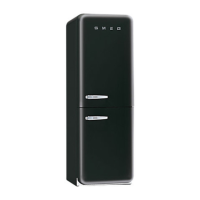
Do you have a question about the Smeg FAB32 RN Series and is the answer not in the manual?
| Freezer Star Rating | 4 stars |
|---|---|
| Climate Class | SN-T |
| Installation | Freestanding |
| Defrost | Automatic |
| Width | 60 cm |
| Number of Doors | 2 |
| Model Series | FAB32 |
Key warnings and guidelines for safe operation of the appliance.
Emphasizes following manual instructions for safety and preventing hazards.
Prohibits outdoor installation for safety and performance reasons.
Basic safety precautions to reduce risks during appliance use.
Cautionary advice regarding child safety and items stored above ranges.
Recommendation on appropriate clothing for safe appliance operation.
Importance and requirements for proper electrical grounding for safety.
Information regarding California's Proposition 65 chemical warnings.
Specific advice on handling grease fires and appropriate extinguishers.
Warning and guidance on preventing child entrapment in discarded appliances.
Instructions for safe disposal of old refrigerators/freezers.
Explains reading conventions and symbols used throughout the manual.
Provides an overview of the appliance's main components and features.
Defines specific parts of the refrigerator and freezer compartments.
Explains the function of the internal fan in distributing temperature.
Describes the purpose and capacity of the freezer compartment.
Details the functions, buttons, and displays of the control panel.
Lists and describes the various accessories provided with the appliance.
Explains the use of the fruit and vegetable drawer for optimal humidity.
Describes the function, positioning, and safety features of shelves.
Explains how to position and use the bottle rack for storing bottles.
Describes the freezer drawers for storing frozen foods and items to be frozen.
Details the use of door balconies and shelves for storing various items.
Explains the use and placement of the egg holder accessory.
Describes the ice tray for producing ice cubes and its placement.
Warnings and precautions for proper appliance usage to avoid damage.
Highlights risks associated with improper appliance usage, like using sharp objects.
Steps to take before initial use, including removing film and cleaning.
Instructions for initial setup, plugging in, and switching on the appliance.
Explains the different alarm functions (door open, temperature) and how to deactivate them.
Describes the control lock function and how to activate/deactivate it.
Guidance on how to use various appliance accessories like shelves and bottle racks.
Instructions on positioning, using, and removing shelves correctly.
How to position and use the bottle rack for storing bottles at an angle.
Advice on storing items in door balconies and shelves, especially bottles.
How to use the fruit and vegetable drawer for optimal storage of fresh foods.
Instructions for removing and using freezer drawers for food storage.
Steps for filling and using the ice tray to produce ice cubes.
Guidance on arranging and storing food in the refrigerator compartment.
Tips for arranging food to preserve quality, prevent contamination, and manage humidity.
Explains the Super Cool function for rapid cooling of large quantities of food.
Instructions for using the freezer compartment effectively for freezing.
Details the Super Freeze function for quick freezing of large food quantities.
Table showing recommended storage times for various types of frozen foods.
Advice on consuming defrosted foods and potential risks.
Explains normal operational noises and potential causes for concern.
Explains the front surface heating system for condensation prevention.
Steps for switching off the appliance for long periods of inactivity.
Tips for efficient food storage and energy saving practices.
Advice on saving energy through proper appliance use and door management.
General recommendations for food storage practices and hygiene.
Guidance on storing items in the refrigerator door, like dairy and drinks.
Advice on arranging food within the refrigerator compartment for optimal storage.
Tips for storing various foods in the freezer compartment effectively.
Storage advice specifically for the freezer compartment door on static models.
Important instructions and warnings for safe and effective appliance cleaning.
Warnings against improper cleaning methods and products that can cause damage.
Safety warning regarding power voltage and unplugging the appliance before cleaning.
General guidelines for cleaning the appliance's interior and exterior surfaces.
How to clean the exterior surfaces using appropriate detergents and tools.
How to clean the interior surfaces and remove ice buildup.
Information on defrosting the refrigerator and freezer compartments.
Manual defrosting instructions for the refrigerator compartment if needed.
Step-by-step guide for safely replacing the interior light bulb.
Troubleshooting guide for common appliance operational issues.
Steps to take if the appliance is not functioning correctly.
Reasons for frequent or continuous compressor operation and solutions.
Causes and solutions for excess ice or condensation in the refrigerator.
Possible causes for water formation inside the refrigerator compartment.
Reasons why the refrigerator compartment is not reaching the desired temperature.
Issues causing food to freeze in the refrigerator compartment.
Causes for the freezer not reaching adequate temperatures to freeze food.
Reasons for excessive ice buildup inside the freezer compartment.
Explanation for difficulty opening the door immediately after closing due to vacuum.
Checks and adjustments for misaligned doors to ensure proper sealing.
Instructions for safely unpacking the appliance and removing packaging materials.
Warning about the weight of the appliance and the risk of crush injuries.
Steps for removing packaging, tape residue, and cleaning surfaces.
Guidelines for safely moving the appliance for cleaning or service.
Instructions for cleaning the interior of the refrigerator before initial use.
Precautions when handling and cleaning glass shelves and covers.
Guidance on selecting the correct location and positioning the appliance.
Emphasizes the need for two people to safely position the appliance.
Warnings about applying pressure on the open door to avoid damage.
Criteria for choosing an appropriate installation location for ventilation and heat.
Importance of proper placement for condenser cooling and airflow.
Danger of electrocution and adherence to electrical safety standards.
Important checks for electrical connection, plug type, and grounding.
